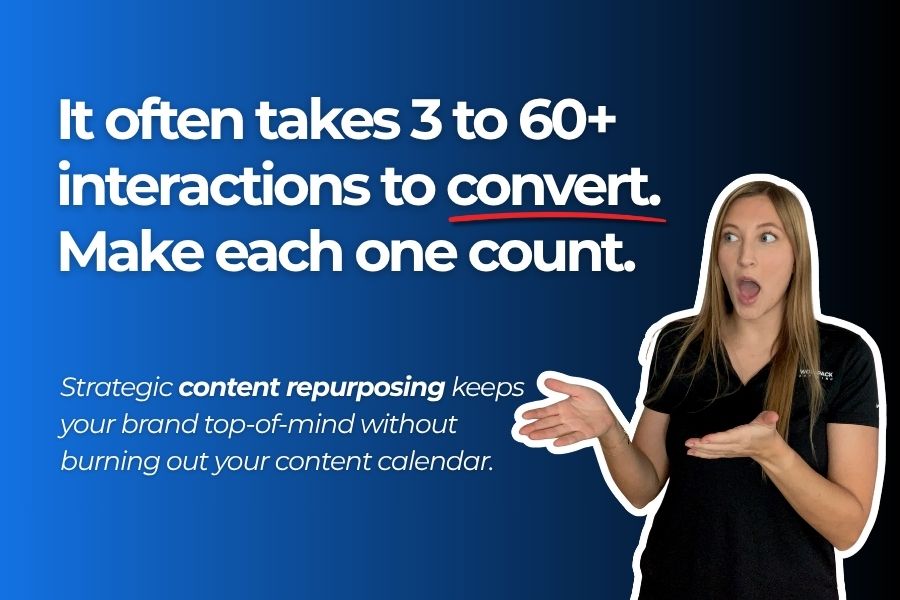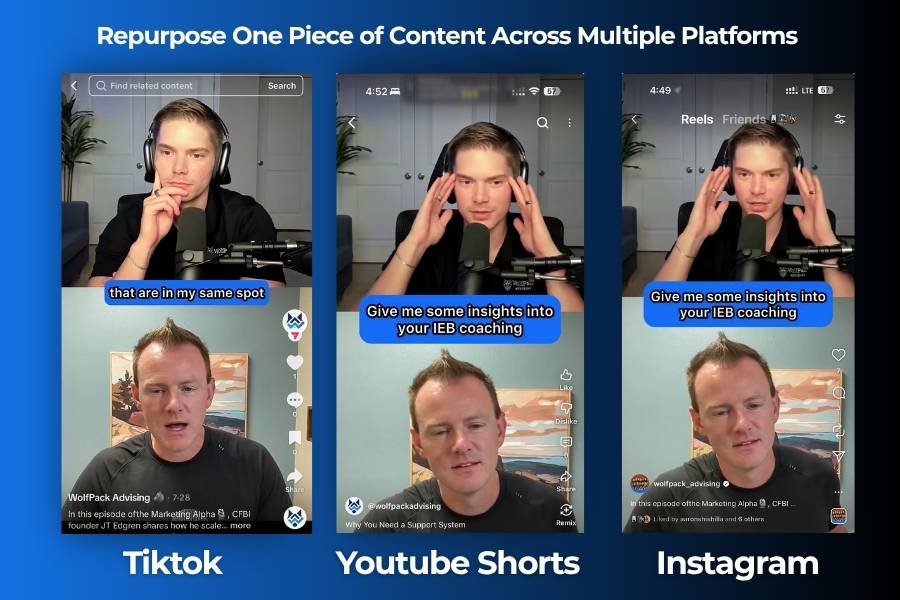Content repurposing strategies help marketers get more results from the work they’ve already done. Instead of constantly creating new content, these strategies focus on transforming your best-performing ideas into fresh formats that reach new audiences. A single blog can turn into a video, an infographic, or a social post, each one strengthening your brand visibility across platforms.
Using smart content repurposing strategies saves time, builds consistency, and supports long-term SEO growth. It’s not about producing more content; it’s about making your existing content work harder and deliver greater impact.

Contents
Turn One Piece of Content into Multiple Touch Points with Content Repurposing
Most business owners don’t realize that it takes 30 to 60+ touch points for a potential customer to finally take action. Seeing your brand once isn’t enough. People need to encounter your message again and again across different platforms before they trust and buy from you.
That’s where content repurposing comes in. Instead of creating new material from scratch each time, you can adapt one high-value piece, such as a blog, video, or podcast, into multiple posts, clips, or visuals. This multiplies your visibility, keeps your message consistent, and helps you stay top of mind without doubling your workload.
Why Repurposing Content Multiplies Your Results
- SEO Growth – Repurposed content increases your chances of ranking for multiple search terms.
- Audience Reach – Sharing the same message across formats means reaching people on their favorite platforms.
- Brand Consistency – A consistent message builds trust and recognition.
- Efficiency – You save time and resources by reusing what already performs well.
- Data Insight – Tracking which versions perform best helps improve future campaigns.
Benefits of Using Content Repurposing Strategies
1. Saves Time and Resources
Instead of starting from scratch, you can update or reframe existing content. This reduces production time and allows your team to focus on strategy.
2. Improves SEO and Visibility
Each repurposed version helps target new keywords, expand your topic authority, and earn more backlinks.
3. Increases Reach Across Channels
By repurposing content into different formats, you reach audiences across YouTube, LinkedIn, and email.
4. Builds Stronger Brand Consistency
When your voice and message align across channels, your audience recognizes and trusts your brand more easily.
5. Extends Content Lifespan
Repurposing keeps valuable content visible and relevant long after it’s published.
Smart Content Repurposing Strategies for Business Owners
These content repurposing strategies help business owners turn one great idea into multiple pieces of content that attract attention, build credibility, and save time. Instead of starting from scratch every week, you can take your best-performing assets and give them new life across different platforms.
1. Turn Blogs into Videos or Reels
At WolfPack, we have turned several high-traffic blog posts into short, engaging videos that reach wider audiences on Instagram, Facebook, and YouTube Shorts.
You can do the same by taking your most valuable blog and pulling out three quick tips or insights to record as short-form video clips. Use your blog outline as your script and always add captions for people who scroll with the sound off.
2. Slice Webinars into Short Clips
If you have hosted a webinar or online workshop, do not let it disappear after the live event. Reuse it by cutting the best insights, quotes, or stats into 30 to 60 second clips for social media or newsletters.
At WolfPack, we have done this by taking a blog about keyword research and turning it into a webinar and later a podcast episode, showing how one idea can fuel multiple content formats.
3. Turn Client Success Stories into Social Proof Content
Your success stories are powerful assets. Turn detailed case studies or client testimonials into bite-sized graphics, LinkedIn carousels, or short videos that highlight key results.
WolfPack often does this by breaking down client campaigns into short posts that spotlight specific metrics like lead growth or ranking improvements, helping other business owners see real results.
4. Combine Long Articles into Downloadable Resources
Bundle your most informative blogs into a helpful guide, checklist, or eBook that people can download. This gives your audience extra value while helping you grow your email list and establish authority.
For example, combine a blog series into “The Ultimate Guide to Home Marketing” or “Your Step-by-Step Social Strategy.”
5. Convert Podcasts or Interviews into Blogs and Quote Graphics
Podcasts are great for engagement, but not easily searchable. Transcribe them and turn the best lessons into blog posts or quick visual quotes for social media. One strong quote can become a shareable graphic that keeps your ideas circulating long after the episode airs.

6. Turn Reports or Data into Visuals
Original data can build trust and authority. Convert key findings into infographics, charts, and social-sharing snippets. Data visuals grab attention and are highly shareable.
Use a short caption that summarizes the insight, and link back to your full report.
Measuring Success from Content Repurposing Strategies
Tracking performance is the best way to understand how well your content repurposing strategies are working. By measuring results, you can see which formats drive the most engagement, traffic, and conversions and adjust your approach to get even better outcomes.
Step 1: Audit Existing Content
Before creating anything new, take a closer look at what’s already working. Review your blogs, videos, and social posts to find high-performing pieces that can be repurposed or expanded.
Start by identifying which assets get the most engagement or visibility:
- Blogs: Look for those with strong traffic, clicks, or time spent on page.
- Videos: Check which ones have higher watch time or consistent views.
- Social Posts: Track likes, shares, comments, or saves that show real audience interest.
Once you have spotted your best content, review the keywords and topics to see if they are still relevant. Group similar pieces into topic clusters so you can build connected posts, videos, and graphics around one core idea. This gives you a clear foundation for repurposing and ensures every new format supports your larger content strategy.
Step 2: Map Opportunities to Multiply Your Touchpoints
Research shows it can take 3 to 60 or more interactions before someone decides to buy or inquire. One post or video is not enough. People need to see your message several times in different ways to build trust and take action.
| Step | Goal | Example |
|---|---|---|
| 1. Audit | Identify top-performing content | Review blogs with strong SEO, videos with high watch time, or posts with strong engagement |
| 2. Map | Plan how to repurpose each asset | Blog → Short Video → Carousel Post → Email Snippet |
| 3. Create | Organize production and assignments | Assign tasks in a project management tool |
| 4. Automate | Streamline publishing and tracking | Schedule posts and monitor performance using your CRM to track campaigns and sources |
| 5. Measure | Evaluate results and refine strategy | Compare reach, traffic, and conversions across formats |
Focus on strategic repurposing instead of creating endless new content. For each high-performing blog, video, or post, list every format you can turn it into.
Examples:
- Turn a blog into short clips or carousel posts.
- Pull key quotes or stats from a webinar and make shareable graphics.
- Transform a client story into a short video or email feature.
Repurposing helps you stay consistent across platforms and move your audience from first impression to conversion faster.
Step 3: Create a Workflow
Assign roles, timelines, and channels. Use a content calendar or repurposing tracker.
Step 4: Automate Distribution
Tools like Buffer, Later, or HubSpot can help schedule posts and automate publishing.
Step 5: Measure and Improve
Track results by format, not just platform. Identify what content types drive the most engagement or conversions.

in one place to see how each piece drives results.
Common Mistakes in Content Repurposing Strategies (and How to Avoid Them)
Repurposing is powerful, but only if done strategically. Avoid these common errors:
- Copy-pasting content without adaptation – Always adjust format, tone, and visuals.
- Ignoring SEO basics – Update titles, metadata, and keywords for each format.
- Posting everything at once – Spread out posts to maintain engagement.
- Skipping analytics – Track each repurposed format to see what works best.
- Inconsistent branding – Use consistent visuals, tone, and CTAs.
Measuring Success from Repurposed Content
Measuring results helps prove the value of repurposing and refine your strategy.
Key Metrics
- Traffic Growth: Increased visits from different channels
- Engagement: Shares, likes, comments, or watch time
- SEO Signals: Keyword rankings and backlinks
- Leads and Conversions: Downloads or inquiries from repurposed content
Use dashboards to compare results by format and platform. If your videos outperform blogs, shift focus accordingly.

How to Get the Most Out of Content Repurposing Strategies
The best content repurposing strategies focus on efficiency and consistency. Start by identifying your top-performing content, then transform it into new formats that match different audience preferences. For example, turn a how-to blog into a quick tutorial video, convert a webinar into bite-sized clips, or redesign a data report as a simple infographic.
Successful content repurposing strategies also rely on planning. Keep a content calendar that tracks what you’ve repurposed, where it’s shared, and how it performs. Over time, you’ll create a sustainable system that saves resources, boosts visibility, and strengthens your overall marketing impact.
Related Questions
What are the best tools for repurposing content?
Use AI-assisted tools for rewriting, transcription, and scheduling to save time and keep workflows simple.
How often should businesses repurpose content?
Refresh or repurpose top-performing content every 3–6 months to keep it relevant.
What is the difference between repurposing and recycling?
Repurposing adapts content into new formats, while recycling reuses it without significant changes.
How can small businesses repurpose with limited resources?
Start with your best blogs or videos and turn them into short-form social content using free tools like Canva or CapCut.
Conclusion
Repurposing content turns one great idea into many valuable pieces. It saves time, improves SEO, and keeps your brand visible across every channel.
When done strategically, repurposing can double or even triple the lifespan of your best content while maintaining quality and consistency. It’s a smart, scalable way to keep your marketing engine running smoothly.
If you outsource parts of your marketing, such as SEO, website management, or social media, work with one marketing agency or partner that can handle all of them together. This ensures your content, campaigns, and messaging stay aligned and every piece supports the same goal.
If your business wants to streamline content creation and maximize results, WolfPack Advising can help you design a system that works.





